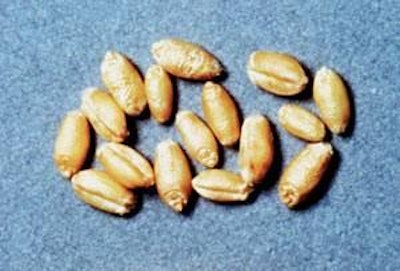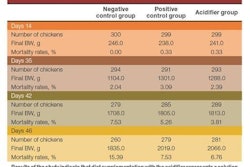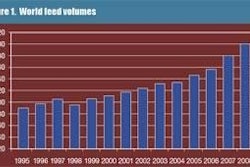
Least-cost formulation techniques to meet nutrient requirements typically dictate ingredient choices for feed products. Usually, the options for change are limited. However, for pelleted feeds, changes in ingredients that make up less than 1% of the formulation can often make significant differences in the physical quality of pellets. Selection of phosphate source, the point in processing of fat addition, and the inclusion of pelleting aids or binders all have a strong influence on pellet durability as well as the efficiency of the pelleting process.
Research suggests that formulation and ingredient selection control about 40% of pellet quality in a range of conventional rations (Behnke, 1996). However, it is impossible to report on potential pelleting effects of each specific ingredient because of the wide variety of ingredients and the potential complexity of diets. Furthermore, substantial variation can exist within the same ingredient coming from different suppliers. The effect of any ingredient must be determined in the pellet in which it will be used. Nonetheless, investigations by this author and others show the possibilities to significantly improve pellet quality and other pelleting parameters through relatively small adjustments in ingredients.
One list of pellet quality factors for 16 common ingredients shows a consensus opinion based on personal pelleting experience (see table 'Pellet quality values'). In theory, a system like this might make it possible to formulate to achieve a particular durability level. In practice, interactions between ingredients and variations in pelleting conditions make this difficult. However, these values can be useful as a general guide.
Corn-soy rations: 'Wheat effect'
Wheat has a particularly high pellet quality value; wheat in the formula can improve pellet durability significantly. Two research trials, a laboratory test and a test in a commercial feed plant, illustrate the ‘wheat effect'.
A laboratory trial was run using a CPM CL Type 2 pellet mill. The basal ration was a straight 3:1 corn-soy (maize-soya) blend. Wheat or lignosulfonate (LS) replaced corn in this mix with no attempt to balance nutrients (see table Replacing corn'). Meal was conditioned to 85°C with 2.07 bar (30 psi) steam. The pellet durability index (PDI) was determined by ASAE Standard 269.1 (the KSU Tumbling Can Method) modified to include two 19-mm (0.75-inch) hex nuts per chamber. Percent reduction of fines (ROF) was calculated by comparing the fines from the basal corn-soy ration to those in the test formulations. This percentage gives the relative binding' strength associated with each change, which shows the positive effect of wheat replacement on pellet durability.
Pellet durability from wheat, binder, and conditioning
A second trial in a commercial feed plant, used a corn-soy turkey ration formulated to include 10% and 20% wheat or 1.25% LS. Pellets were made on a CPM 7800 pellet mill at a production rate of 34.5 tonnes per hour (metric tons per hour, tph, or 38 short tons per hour, stph). Conditioning temperature varied, but was recorded at the time of sampling. Pellet durability was measured using the KSU method with two 19-mm (0.75-inch) hex nuts per chamber. Results were plotted as a function of conditioning temperature (see Pellet durability'). The slope of the trend lines are different for wheat and LS, suggesting that wheat is more strongly affected by the addition of conditioning steam. Increasing the level of wheat from 10% to 20% clearly increased pellet durability. Adding 1.25% LS was nearly as effective as 20% wheat, similar to the results achieved in the lab trial.
A third test was made in the lab to compare the effect of replacing 12.5% and 25% of the corn with wheat, triticale, or barley (see table Fine grains'). Triticale is a hybrid of wheat and rye and its binding characteristics proved to be similar to those of wheat. Replacing corn with barley improved pellet durability, but not to the same degree as was observed with wheat or triticale.
In cases where maize or yellow corn replaces wheat in the ration, binder is sometimes added to maintain product consistency.
Wheat midds, a co-product of flour milling, are widely available for use in feed manufacture. They generally make a good-quality pellet, but do not seem to respond strongly to the heat of steam conditioning. Dairy concentrate pellets that contain 40% midds can be processed at 50°C or 70°C with almost no difference in pellet durability.
Soybean meal: Effect from particle size or fat?
For the other main ingredient in corn-soy rations, soybean meal (SBM), research had suggested little effect on pellet durability. To investigate, a trial was conducted in a commercial feed plant comparing SBM from two suppliers that were thought to provide different grinds. The trial was run using a 37% all-vegetable protein concentrate that contained 70% SBM. Results showed a clear difference in pellet durability between the two sources of meal (see figure ‘Different soya').
However, particle size analyses failed to show a significant difference in grind. What proved important was the difference in fat content. Proximate analyses revealed that meal from Supplier B contained 1.0% fat, versus 0.6% from Supplier A. This trial was run on a computerised pellet mill with set points of 150 amps and 72°C. The controller adjusted production rate to achieve the desired amperage. Average production rate with meal containing 1.0% fat was 12.3 tph (13.5 stph), versus 11.2 tph (12.3 stph) with 0.6% fat.
It is significant to note that pellet quality did not increase with higher conditioning temperatures. This is a typical response in rations that have a high SBM content, and is much different than is seen with rations high in starch (see table Pellet quality'). The slight negative trend in pellet durability with increasing temperature in this trial was probably related to production rate. The ration based on Supplier B's SBM increased from 10.9 tph (12.0 stph) to 13.2 tph (14.5 stph) as temperature increased.
Fat: Care with application
Adding fat to the feed mash prior to pelleting is simply the worst thing that can happen to pellet quality. Adding fat to the mixer or conditioner hurts pellet durability by lubricating the extrusion process, and thereby reducing the pressure that is applied in forming the pellet. Furthermore, it creates a hydrophobic film over the feed particles that prevents them from binding together.
A trial was run in a commercial turkey feed operation to determine whether conditioning temperature could be increased by the addition of fatand thereby improve pellet durability. At this particular feed plant, it was impossible to raise the temperature above 77°C without choking the pellet mill. Addition of 1% fat provided lubrication, which allowed pelleting temperature to increase to 82°C. However, the negative effect the fat had on binding erased any benefit of the higher temperature of mash conditioning (see figure Fat').
Fat should be applied post-pelleting whenever possible. When sprayed onto the hot pellet as it comes off the die, the effect on pellet quality is generally neutral. However, if the pellets are screened and fines returned for re-pelleting, then fat that is returned with the fines will have a strong negative effect. Even when pellets are not screened, fines are sometimes transferred in air stream to the cyclones and returned to the pellet mill. Application of fat to the pellets after cooling results in the best possible pellet durability. When applied in this manner, the fat tends to stay on the surface of the pellet, reducing dust and lubricating the pellet to reduce abrasion.
Phosphates and pellet quality
Defluorinated or tri-calcium phosphate is known to allow pellet mills to produce at a faster rate (Behnke, 1981). When defluorinated phosphate is replaced by di-calcium phosphate, there is increased resistance to extrusionthe production rate declines and pellet durability improves. A typical response is seen when di-calcium phosphate in a turkey grower feed is replaced by defluorinated phosphate in a finisher diet (see table Phosphorus').
These rations were processed on the same pellet millboth at 36.3 tph (40 stph) and 84°C. Di-calcium phosphate in the grower ration increased resistance to extrusion, effectively increasing the amount of energy the pellet mill used to push the pellets through the die (6.5 versus 5.4 kWh/short ton). This extra work increased compaction and made a more durable pellet (87.4 PDI versus 80.9 PDI). It is possible that some of the response was caused by the addition of bakery by-product or a shift in the corn-soy ratio, but the observed result is believed to be typical of the response to phosphate alone. A second example with no bakery by-product shows similar results.
Binders: clays and lignosulfonates
Clays are sometimes used as binders for pelleted feeds. They are often inexpensive and may be cost-effective fillers in rations that are not nutritionally densesuch as range cubes. Research at Kansas State University (Pfost, 1973) showed that addition of 2% bentonite clay to a medium-grind corn-soy pellet could reduce fines from 11.7% to 7.8% when conditioning temperature rise was 32°C.
However, not all clays are effective in pellet binding. Moreover, even though the trade or generic name of the clay feed additive product may include the word ‘binder', the term may refer to mycotoxin binding, not pellet binding!
Five clay binders were evaluated on a pilot plant pellet mill. The basal ration contained 70% ground corn, 30% SBM, and vegetable oil added last. A positive control was mixed without oil. Each of five clays was added on top of the ration at a level of 2%. Rations were prepared in triplicate and conditioned to 80°C with 2.07 bar (30 psi) steam prior to pelleting. Durability with no added fat or binder was 58.9 PDI, using the LignoTester, rather than the KSU tumbling can (see table 'Clays'). This low PDI value was due in part to the use of the more aggressive durability tester, although delivery of 60% pellets is not uncommon for swine and broilers. Addition of 2% fat reduced durability to 38.8 PDI. Addition of 2% of Clay 1, Clay 2 and Clay 3 showed little or no improvement in durability. Clay 4, a sodium bentonite, brought durability back up to 56.7 PDI. Clay 5 had the strongest pellet binding response, in part due to its ability to increase compression by resisting extrusion.
Different clay products yield different binder performance. It is not safe to assume that one clay can be substituted for anothertesting is required. Although there is larger variation between clays, within a product line the consistency is usually very good.
Lignosulfonates are the most widely-used binders in the feed industry (Castaldo, 1998). Early research at Kansas State University (Pfost, 1964) showed that addition of 1% lignosulfonate to a corn-soy turkey finisher pellet could reduce fines from 8.2% to 4.9% when conditioning temperature rise was 28°C and die hole dimensions of 4.8 mm (3/16 inch) diameter by 50.8 mm (2.0 inches) depth. Dr Pfost also documented lubrication properties of lignosulfonates and demonstrated that they were effective across a wide range of conditioning temperatures. Lignosulfonates are generally twice as effective as clays (Pfost, 1976; see table 'Clays') and approximately 15-20 times more effective than wheat (see table 'Replacing corn' and figure 'Pellet durability').
The complexities of feed formulation and variables in feed processing make it difficult to predict with accuracy the effects on pellet quality of individual ingredients. However, certain ingredients do promote pellet durability, while others tend to reduce PDI. Strong influences include selection of phosphate source, the point in processing of fat addition, and the inclusion of wheat and micro ingredient pelleting aids or binders.
Soybean production for 2006-07 in the USA is projected at 83.82 tonnes (metric tons or mt), according to the US Department of Agriculture (USDA) reporting in June. USDA analysts note that such output could result in ending stocks at a record 17.8 mt, up 2.3 mt from 2005-06. USDA also expects a lower soybean crush for 2005-06, reflecting lower-than-expected domestic soybean meal use in the first half of 2006, as increased soybean meal exports partly offset reduced domestic use. USDA says that soybean ending stocks for 2005-06 likely will be 15.5 mt.
Vitamin D3 for
Nelore beef cattle (Bos indicus) are hardy and thrifty under tropical and subtropical conditions, but carcase composition and meat quality can vary significantly. In order to economically improve Nelore beef tenderness, researchers with the University of São Paulo (USP) in Brazil have experimented with supplementary vitamin D3.
Vitamin D3 is important for calcium mobilisation, acting on the intracellular calcium-dependent proteases (µ-calpain and m-calpain). Reporting in Scientia Agricola, USP researchers, including Carla de Moura Silveira Pedreira, and others, fed Nelore steers 0, 3, 6 and 9 million IU of supplemental vitamin D3 per animal per day (an-1 d-1) for 10 days prior to slaughter. The steers were slaughtered and tenderness (shear force), cooking losses (after 1, 8 and 15 days of aging), sensory evaluation, and minerals in blood plasma and rib-eye muscle (Longissimus dorsi) were measured.
American Feed Industry Association president Joel Newman delivered the keynote address before Chinese and international industry leaders at the Feed Forum just prior to the annual Industry Exhibition and Trade Fair in Nanjing, China in June. Mr Newman also represented AFIA at a meeting of F4 countriesthe four largest feed producing entities, representing 72% of the world feed productionsponsored by the International Feed Industry Federation. The F4 group consists of the USA, China, Brazil, and the European Union.
The F4 meeting focused primarily on the organisation's partnership with the United Nation's Food and Agriculture Organization, involving the completion of a Codex implementation manual for all feed producing countries and conducting training workshops for individual countries. The group considered several recommendations for the next phase of the Codex process as it pertains to feed and advanced a project to achieve equivalency recognition between global trading partners on safety and regulatory requirements. Other critical developments discussed included bovine spongiform encephalopathy (BSE) and highly pathogenic avian influenza (HPAI).
IFIF also reviewed plans for a second Global Feed and Food Safety Congress in Brazil, tentatively scheduled for Sao Paulo in April 2007. For more, see the AFIA's Feedgram at www.afia.org.

















